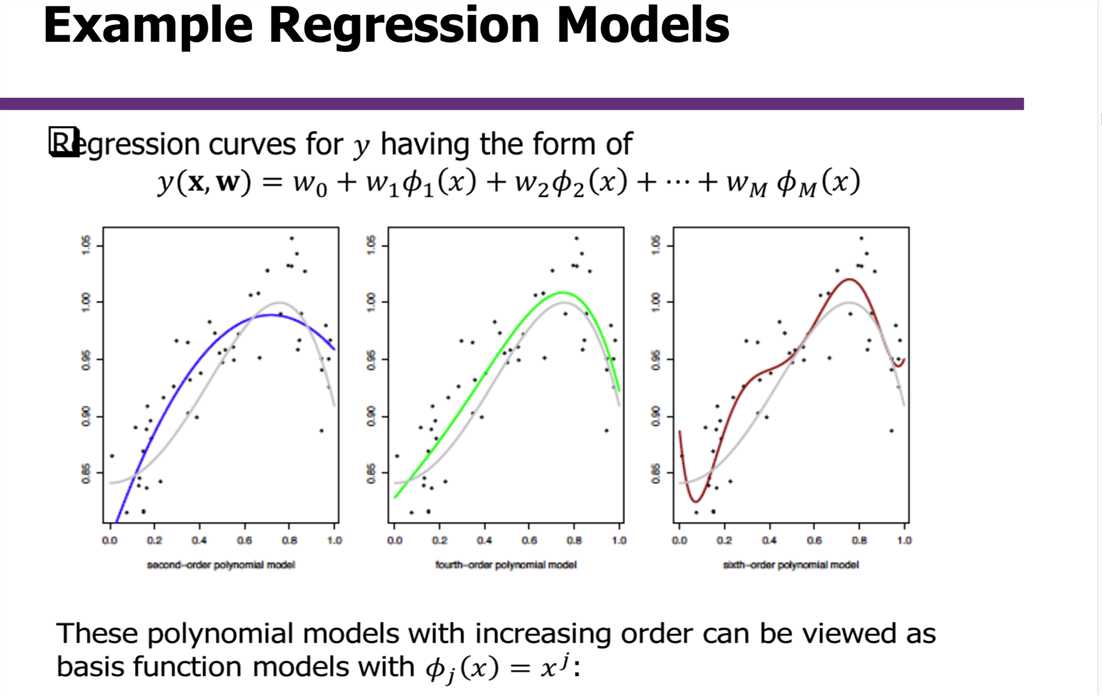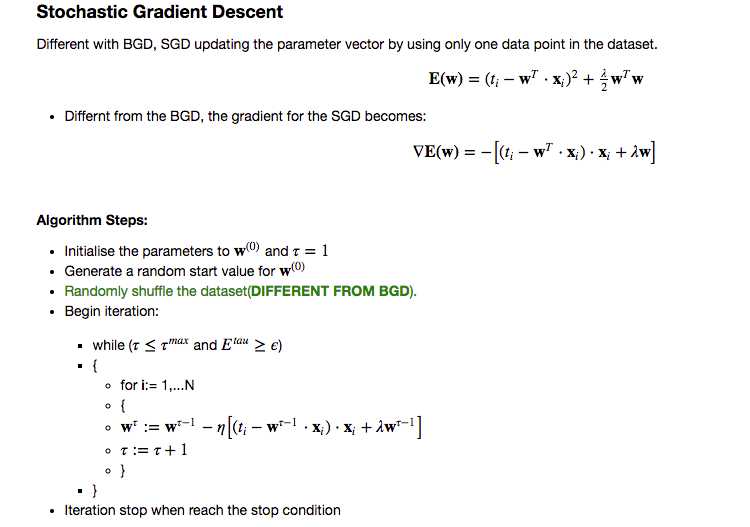标签:随机梯度 bubuko run 算法 object shuff assign 计算 图片
本编博客继续分享简单的机器学习的R语言实现。
今天是关于简单的线性回归方程问题的优化问题

常用方法,我们会考虑随机梯度递降,好处是,我们不需要遍历数据集中的所有元素,这样可以大幅度的减少运算量。
具体的算法参考下面:
首先我们先定义我们需要的参数的Notation


上述算法中,为了避免过拟合,我们采用了L2的正则化,在更新步骤中,我们会发现,这个正则项目,对参数更新的影响
下面是代码部分:
## Load Library
library(ggplot2)
library(reshape2)
library(mvtnorm)
## Function for reading the data
read_data <- function(fname, sc) {
data <- read.csv(file=fname,head=TRUE,sep=",")
nr = dim(data)[1]
nc = dim(data)[2]
x = data[1:nr,1:(nc-1)]
y = data[1:nr,nc]
if (isTRUE(sc)) {
x = scale(x) ## Scale x
y = scale(y) ## Scale y
}
return (list("x" = x, "y" = y))
}
我们定义了一个读取数据的方程,这里,我们会把数据集给scale一下,可以保证进一步提高运算速度
## Matrix Product Function
predict_func <- function(Phi, w){
return(Phi%*%w)
}
## Function to compute the cost function
train_obj_func <- function (Phi, w, label, lambda){
# Cost funtion including the L2 norm regulaztion
return(.5 * mean((predict_func(Phi, w) - label)^2) + .5 * lambda * t(w) %*% w)
}
## Return the errors for each iteration
get_errors <- function(data, label, W) {
n_weights = dim(W)[1]
Phi <- cbind(‘X0‘ = 1, data)
errors = matrix(,nrow=n_weights, ncol=2)
for (tau in 1:n_weights) {
errors[tau,1] = tau
errors[tau,2] = train_obj_func(Phi, W[tau,],label, 0) ## Get the errors, set the lambda to 0
}
return(errors)
}
同时,我们定义了计算矩阵乘法,计算目标函数以及求误差的方程。
sgd_train <- function(train_x, train_y, lambda, eta, epsilon, max_epoch) {
## Prepare the traindata
## Attach the 1 for X0
Phi <- as.matrix(cbind(‘X0‘=1, train.data))
## Calculate the max iteration time for the SGD
train_len = dim(train_x)[1]
tau_max = max_epoch * train_len
W <- matrix(,nrow=tau_max, ncol=ncol(Phi))
set.seed(1234)
## Random Generate the start parameter
W[1,] <- runif(ncol(Phi))
tau = 1 # counter
## Create a dateframe to store the value of cost function for each iteration
obj_func_val <-matrix(,nrow=tau_max, ncol=1)
obj_func_val[tau,1] = train_obj_func(Phi, W[tau,],train_y, lambda)
while (tau <= tau_max){
# check termination criteria
if (obj_func_val[tau,1]<=epsilon) {break}
# shuffle data:
train_index <- sample(1:train_len, train_len, replace = FALSE)
# loop over each datapoint
for (i in train_index) {
# increment the counter
tau <- tau + 1
if (tau > tau_max) {break}
# make the weight update
y_pred <- predict_func(Phi[i,], W[tau-1,])
W[tau,] <- sgd_update_weight(W[tau-1,], Phi[i,], train_y[i], y_pred, lambda, eta)
# keep track of the objective funtion
obj_func_val[tau,1] = train_obj_func(Phi, W[tau,],train_y, lambda)
}
}
# resulting values for the training objective function as well as the weights
return(list(‘vals‘=obj_func_val,‘W‘=W))
}
# updating the weight vector
sgd_update_weight <- function(W_prev, x, y_true, y_pred, lambda, eta) {
## Computer the Gradient
grad = - (y_true-y_pred) * x
## Here I just combine the regularisation term with prev w
return(W_prev*(1-eta * lambda) - eta * grad)
}
根据上述我们写的计算更新目标函数和参数的方法,讲算法用R实现
下面是实验部分
## Load the train data and train label train.data <- read_data(‘assignment1_datasets/Task1C_train.csv‘,TRUE)$x train.label <- read_data(‘assignment1_datasets/Task1C_train.csv‘,TRUE)$y ## Load the testdata and test label test.data <- read_data(‘assignment1_datasets/Task1C_test.csv‘,TRUE)$x test.label <- read_data(‘assignment1_datasets/Task1C_test.csv‘,TRUE)$y # Set MAX EPOCH max_epoch = 18 ## Implement SGD with Ridge regression options(warn=-1) ## Initilize ## Set the related parameters epsilon = .001 ## Terimation threshold eta = .01 ## Learning Rate lambda= 0.5 ## Regularisation parmater ## Run SGD ## Cost function values train_res2 = sgd_train(train.data, train.label, lambda, eta, epsilon, max_epoch) ## Calulate the errors ## To be mentioned here, we will only visulisation for the train error to check the converge result errors2 = get_errors(train.data, train.label, train_res2$W)
接着,我们把SGD的error plot给绘制出来
## Visulastion for SGD
plot(train_res2$val, main="SGD", type="l", col="blue",
xlab="iteration", ylab="training objective function")

这里我们的方程比较简单,可以看到,目标函数很快就收敛了。
标签:随机梯度 bubuko run 算法 object shuff assign 计算 图片
原文地址:https://www.cnblogs.com/chenyusheng0803/p/9657049.html